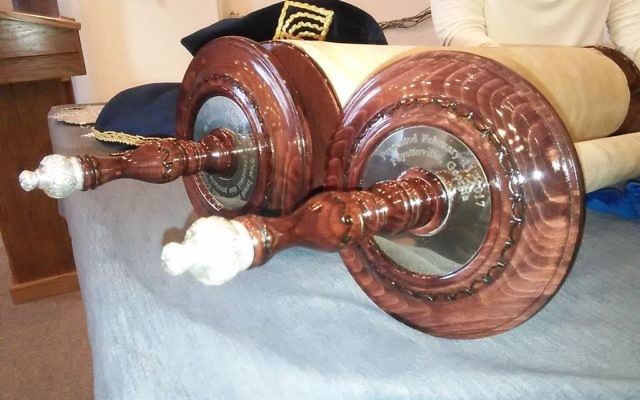B’nai Israel Bolsters Holocaust Torah
Congregation B’nai Israel in Fayetteville now has new rollers for its Holocaust Torah.
When Congregation B’nai Israel began a fundraiser in January and invited congregants to “tie one on,” congregants were perplexed. What did the Reform synagogue expect them to do?
While the expression “tie one on” usually involves imbibing alcohol, at CBI it meant something different — something respectful and essential.
Congregation B’nai Israel, located in eastern Fayetteville, is charged with the care and use of a Holocaust Torah, one of the 1,564 Torah scrolls that were rescued during the war. This care requires that the Torah scroll be rolled from one end to the other twice a year and read on several occasions.
Last summer, during one of the carefully orchestrated rollouts, something went askew. Susan Burden, CBI’s cantorial soloist, said the top of one of the aytz chayim (rollers) attached to the holy scroll rolled off and went down the bimah and then down the stairs.
The rollers, which had been attached in the 1990s, needed to be replaced and thus the Torah scroll honored.

Tie one on meant carefully and respectfully sewing on new rollers.
CBI purchased beautiful rollers and began fundraising for the cost. Within weeks, the Reform congregation of 60 families had raised $10,000.
Donations earned the givers a once-in-a-lifetime opportunity to stitch the Torah scroll to the aytz chayim. Twelve stitchers were needed.
The ceremonial stitching occurred Saturday, Feb. 11, after a Havdalah service. Congregants, some with spouses and other family, walked onto the bimah to add the required stitches.
One donor offered the opportunity for the recent b’nai mitzvah to participate. All six young adults showed up to do stitches.
One donor paid more than $4,000 to do the first stitch.
Burden explained the importance of the event to those present and shared instructions on how to do the attachment.
Special scissors and kosher sinew thread were required. Gold-plated scissors were purchased because no metal that can be used for weapons may touch the Torah. The stitching was done by careful congregants, some of whom held their breath while others’ hands were shaking.
Those present said it was an incredible experience that made them feel a part of the history of the Holocaust Torah. Some attendees were amazed that ordinary Jewish people were allowed to perform the attachment.
CBI’s Holocaust Torah comes from a small town, Sobeslav, in what is now the Czech Republic. Jews settled there in the 16th century but were ousted in 1606 and moved to neighboring towns.
In 1848 Jews were again allowed to live in the village. It was a small but thriving community with a synagogue that housed two Torahs.
In November 1942, all the Jews were deported to the Theresienstadt concentration camp and from there to Auschwitz to be killed. The only Holocaust survivors from Sobeslav were the two Torahs and two residents. One of the Torahs is on permanent loan to Congregation B’nai Israel, and the other is with Temple Beth Shalom in Needham, Mass.
The synagogue in Sobeslav was used after the war for storage until it was torn down in 1959, according to Florence Shumacher’s article about the Temple Beth Shalom Holocaust Torah in November 2015.





comments